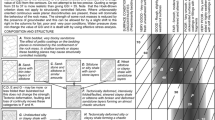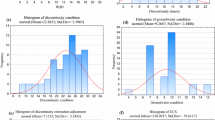Abstract
Three-dimensional, elastic and elasto-plastic finite element (FE) programs have permitted calculation of the displacements and the factor of safety (FOS) for the excavation for a tower, 132.70 m high (above foundation) on the island of Tenerife. The tower is supported by a 2 m thick reinforced concrete slab on jointed, vesicular and weathered basalt and scoria. The installation of rod extensometers at different depths below the slab has permitted comparison between measured and calculated displacements and the estimation of in situ deformation modulus. The moduli deduced from the simple empirical equations proposed by Hoek et al. (In: NARMS-TAC, 2002) and Gokceoglu et al. (Int J Rock Mech Min Sci 40:701–710, 2003) as a function of GSI, and Nicholson and Bieniawski (Int J Min Geol Eng 8:181–202, 1990) as a function of RMR, provide an acceptable fit with the measured settlements in this type of rock. Good correlation is also obtained with the empirical equation presented by Verman et al. (Rock Mech Rock Eng 30(3):121–127, 1997) that incorporates the influence of confining stress in the deformation modulus. The FOS obtained from different correlations with geomechanical classifications is within a relatively narrow range. These results increase our confidence in the use of classification schemes to estimate the deformation and stability in jointed rock.














Similar content being viewed by others
References
Balmer G (1952) A general analytical solution for Mohr’s envelope. Am Soc Test Mater 52:1269–1271
Barton N (2002) Some new Q-value correlations to assist in site characterization and tunnel design. Int J Rock Mech Min Sci 39:185–216
Bieniawski ZT (1974) Geomechanics classification of rock masses and its application in tunnelling. In: Proceedings of the third congress of the international society for rock mechanics. Denver, pp 23–32
Bieniawski ZT (1979) The geomechanics classification in rock engineering applications. In: Proceedings of the fourth congress of ISRM, vol 2, Montreux, pp 41–48
Boyd RD (1993) Elastic properties of jointed rock masses with regard to their rock mass rating value. In: Cripps JC et al (eds) The engineering geology of weak rock. Balkema, Rotterdam, pp 329–336
Cai M, Kaiser PK, Uno H, Tasaka Y, Minami M (2004) Estimation of rock mass deformation modulus and strength of jointed hard rock masses using the GSI system. Int J Rock Mech Min Sci 41:3–19
Gokceoglu C, Sonmez H, Kayabasi A (2003) Predicting the deformation moduli of rock masses. Int J Rock Mech Min Sci 40:701–710
Gurocak Z, Kilic R (2005) Effect of weathering on the geomechanical properties of the Miocene basalts in Malatya, Eastern Turkey. Bull Eng Geol Environ 64(4):373–381
Hammah RE, Curran JH, Yacoub T, Corkum B (2004) Stability analysis of rock slopes using the finite element method. EUROCK 2004 & 53 Geomechanics Colloquium, Schubert
Hammah RE, Yacoub T, Corkum B, Curran JH (2005) A comparison of finite element slope stability analysis with conventional limit-equilibrium investigation. In: Proceedings of 58th Canadian geotechnical and 6th joint IAH-CNC and CGS groundwater specialty conferences, Saskatoon, Saskatchevwan, Canada, September
Hoek E (1983) Strength of jointed rock masses. 23rd Rankine Lecture. Géotechnique 14(3):187–223
Hoek E (1994) Strength of rock and rock masses. ISRM New J 2(2):4–16
Hoek E (2006) Roclab 1.0. Rock mass strength analysis using the generalized Hoek–Brown failure criterion. Hoek’s Corner. Internet
Hoek E, Brown ET (1997) Practical estimates of rock mass strength. Int J Rock Mech Min Sci 40:701–710
Hoek E, Diederichs MS (2006) Empirical estimation of rock mass modulus. Int J Rock Mech Min Sci 43:203–215
Hoek E, Kaiser PK, Bawden WF (1995) Support of underground excavations in hard rock. Balkema, Rotterdam, p 215
Hoek E, Carranza-Torres C, Corkum B (2002) Hoek–Brown failure criterion-2002 edition. In: Proceedings of 5th North American Rock Mechanics Symposium and Tunneling Association of Canada Conference: NARMS-TAC, pp 267–271
ISRM (1981) Brown ET (ed) Rock characterization, testing and monitoring, ISRM suggested methods. Pergamon Press, Oxford, 211 pp
Jiménez Salas JA, Justo JL, Serrano A (1981) Geotecnia y Cimientos. II. Mecánica del Suelo y de las Rocas. Rueda, Madrid
Justo JL, Justo E, Durand P, Azañón JM (2006) The foundation of a 40-storey tower in jointed basalt. Int J Rock Mech Min Sci 43:267–281
Kayabasi A, Gokceoglu C, Ercanoglu M (2003) Estimating the deformation modulus of rock masses: a comparative study. Int J Rock Mech Min Sci 40:55–63
McMahon MD, McMahon BK (1980) Foundation investigation and monitoring. Structural foundations in rock. Balkema, Rotterdam, pp 153–160
Mitri HS, Edrissi R, Henning J (1994) Finite element modelling of cable-bolted slopes in hard rock ground mines. In: Presented at the SME annual meeting. Albuquerque, New Mexico, pp 94–116
Nicholson GA, Bieniawski ZT (1990) A nonlinear deformation modulus based on rock mass classification. Int J Min Geol Eng 8:181–202
Palmström A, Singh R (2001) The deformation modulus of rock masses—comparisons between in situ tests and indirect estimates. Tunnel Undergr Space Technol 16:115–131
Plaxis (2005) Plaxis 3-D Foundation. Version 1.5 manual. In: Brinkgreve RBJ, Broere W (eds) Delft Univ. and Plaxis BV, The Netherlands
Read SAL, Richards LR, Perrin ND (1999) Applicability of the Hoek–Brown failure criterion to New Zealand greywacke rocks. In: Vouille G, Berest P (eds) Proceedings of ninth international congress on rock mechanics, vol 2, Paris, pp 655–660
Rocscience (2004) Application of the finite element method to slope stability. Rocscience Inc., Toronto
Ruiz MD, Camargo FP, Midea NF, Nieble CM (1968) Some considerations regarding the shear strength of rock masses. In: International symposium on rock mechanics, Madrid, pp 159–169
Schultz RA (1995) Limits on strength and deformation properties of jointed basaltic rock masses. Rock Mech Rock Eng 28(1):1–15
Serafim JL, Pereira JP (1983) Considerations on the geomechanical classification of Beniawski: experience from case histories. In: Proceedings of symposium on engineering geology and underground openings, Lisbon, pp 1133–1144
Sonmez H, Ulusay R (1999) Modifications to the geological strength index (GSI) and their applicability to stability of slopes. Int J Rock Mech Min Sci 36:743–760
Sonmez H, Gokceoglu C, Ulusay R (2004) Indirect determination of the modulus of deformation of rock masses based on GSI system. Int J Rock Mech Min Sci 41:849–857
Sonmez H, Gokceoglu C, Nefesalioglu HA, Kayabasi A (2006) Estimation of rock modulus: for intact rocks with an artificial neural network and for rock masses with a new empirical equation. Int J Rock Mech Min Sci 43:224–235
Verman M, Singh B, Viladkar MN, Jethwa JL (1997) Effect of tunnel depth on modulus of deformation of rock mass. Rock Mech Rock Eng 30(3):121–127
Zhang L, Einstein HH (2004) Using RQD to estimate the deformation modulus of rock masses. Int J Rock Mech Min Sci 41:337–341
Acknowledgments
A grant from the Spanish Ministry of Education and Science to investigate the problem of ‘hanging’ towns has permitted this research to be carried out.
Author information
Authors and Affiliations
Corresponding author
Additional information
An erratum to this article can be found at http://dx.doi.org/10.1007/s00603-009-0073-x
Appendix: Estimate of Rock Mass Strength
Appendix: Estimate of Rock Mass Strength
The generalized Hoek–Brown failure criterion for jointed rock masses is defined by the equation:
where m b is a reduced value of the intact rock constant m i and is given by
s and a are constants for the rock mass given by the following relationships:
D is a factor which depends upon the degree of disturbance to which the rock mass has been subjected by blast damage and stress relaxation. It varies from 0 for undisturbed rock masses to 1 for very disturbed rock masses. The excavation in Tenerife was carried out by mechanical means and a value of 0.7 for the strata in the front of the excavation and 0 for the layers below the foundation have been used.
Hoek (1983) showed that, for brittle materials, the uniaxial tensile strength is equal to the biaxial strength. The tensile strength is obtained by setting \( \sigma^{\prime}_{1} = \sigma^{\prime}_{3} = \sigma_{\text{t}} \) in Eq. 10 which represents a condition of biaxial tension.
Normal and shear stresses at failure are related to principal stresses by the equations given by Balmer (1952):
Deriving Eq. 10 and operating:
Since most geotechnical software is still written in terms of the Mohr–Coulomb failure criterion, it is necessary to determine equivalent angles of friction and cohesive strengths for each rock mass and stress range. This is done by fitting an average linear relationship to the curve generated by solving Eq. 10 for a range of minor principal stress values defined by \( \sigma_{\text{t}} < \sigma^{\prime}_{3} < \sigma^{\prime}_{{3{ \max }}} \) as illustrated in Fig. 15a.
The well-known linear relationship for the Mohr–Coulomb criterion is
which may be simplified as
where σ cm is the uniaxial compressive strength of the rock mass corresponding to the linear Mohr–Coulomb relationship, and k is the slope of the straight line relating \( \sigma^{\prime}_{1} \) and \( \sigma^{\prime}_{3} \).
The values of Φ′ and c′ can be calculated equalizing the first and the second terms respectively of the right hand side of Eqs. 18 and 19, and operating:
The problem of fitting the linear relationship (19) to Eq. 10 has been solved analytically by Hoek et al. (2002) who have found the following equations:
where \( \sigma^{\prime}_{3n} = \sigma^{\prime}_{{3{ \max }}} /\sigma_{\text{ci}} \).
The normal stress-shear stress relationships are represented in Fig. 15b.
The selected level of \( \sigma^{\prime}_{{3{ \max }}} \) has a great influence on the values of c′ and Φ′ obtained in this analysis. In some rock stability problems, the effective normal stress on some parts of the failure surface can be quite low. In these cases, the value of \( \sigma^{\prime}_{{3{ \max }}} \), the upper limit of confining stress over which the relationship between the Hoek–Brown and the Mohr–Coulomb criteria is considered has to be determined from an appropriate stress analysis technique. Using Bishop’s circular failure analysis for a wide range of slope geometries and rock mass properties, Hoek et al. (2002) present the following equation for slopes:
where H is the height of the slope.
This approach has been used to find the Mohr–Coulomb parameters for the different basalt types included in Tables 13 and 10. As the upper basalt is in the front of the excavation, Eq. 24 has been employed to find \( \sigma^{\prime}_{{3{ \max }}} \). For basalt types d1 to d3, which are interspersed below the foundation, the maximum \( \sigma^{\prime}_{3} \) value obtained in the elastic FE calculations (Sect. 5.1) has been chosen (1 MPa). The calculations have been carried out using the RocLab 1.0 program (Hoek 2006). The results are included in Table 13.
Rights and permissions
About this article
Cite this article
Justo, J.L., Justo, E., Azañón, J.M. et al. The Use of Rock Mass Classification Systems to Estimate the Modulus and Strength of Jointed Rock. Rock Mech Rock Eng 43, 287–304 (2010). https://doi.org/10.1007/s00603-009-0040-6
Received:
Accepted:
Published:
Issue Date:
DOI: https://doi.org/10.1007/s00603-009-0040-6





